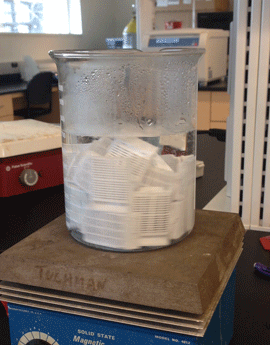Last week, we got a surprise present for the lab (surprise for me at least). A brand spanking new Flash Carbon and Nitrogen Combustion Analyzer! The C&N combustion analyzer does just that: it analyzes the carbon and nitrogen in a sample by burning it at 980 degrees celsius and then 850 degrees celsius until the sample is completely vaporized. I know, pretty hot, huh?
 |
| The Flash C&N Combustion Analyzer. |
Those two shiny cylinders are the furnaces. They get very hot, as hot as an iron at high temperature. I should know, I couldn't resist (everyone was doing it!). The white tube with red caps is the moisture trap, and the large box behind it is the detector.
 |
| Our auto-sampler with two carousels. |
This is the auto-sampler. It holds the samples and drops them into the first furnace. Our auto-sampler can hold four carousels- 100 total samples! In the main part of the sampler, there is a piston that pushes the sample into the chrome tube underneath that leads to the furnace.
 |
| A carousel with 11 samples loaded. |
The Flash analyzer can only process samples that are between about 5-100mg. That's very small. Unfortunately, to get acurate results, we have to buy a new balance for the lab that is accurate to the 0.01mg. Our current balance, that we just got at the beginning of the summer, is only accurate to the 1mg which is apparently not good enough for the Flash analyzer (well, la dee da). Once the sample is massed out in a small tin cartage, it must be balled up to fit into the machine.
 |
| Susanna, making a perfect sample ball. |
In the first 15 seconds after the sample is dropped into the first furnace, an eerie red light flashes and glows from the eye of the auto-sampler. This is the reflection of the sample combusting at almost a thousand degrees celsius.
 |
| The burning eye of the auto-sampler is watching. |
When the samples have finally dropped into the furnace, vaporized, and gone through the detector, the computer spits out this:
 |
| The not-so-impressive-looking C&N data. |
It doesn't look like much, but the area under the peaks (the integral) tells us quantifiably how much nitrogen and carbon was in the sample. The first peak is the amount of nitrogen detected and the second peak is the amount of carbon detected. Once you understand the process and what the graph means, it actually is pretty awesome. You know, for nerds like us.











